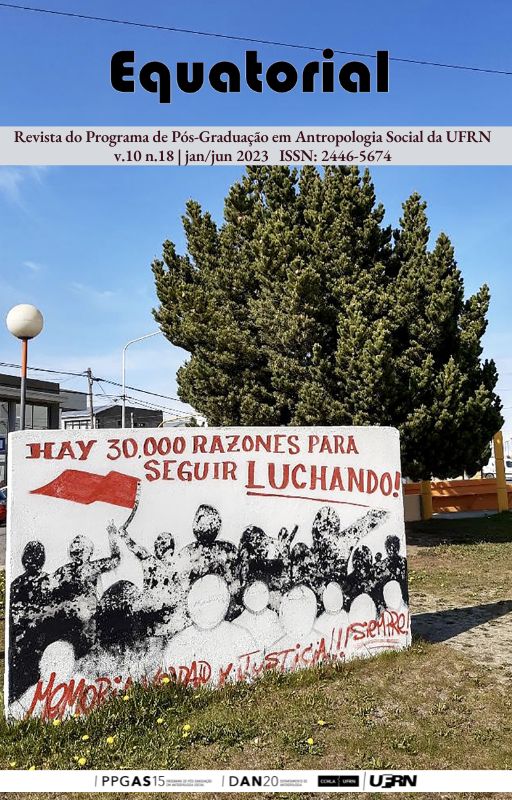Day of the dead in the second year of pandemic
the phases of experiencing death in the "new normal" cemetery
DOI:
https://doi.org/10.21680/2446-5674.2023v10n18ID30686Keywords:
Anthropology of death, Cemetery, PandemicAbstract
The photo essay addresses the theme of the day of the dead in its ritualistic pandemic context in the city of João Pessoa, Paraíba, more precisely in the Senhor da Boa Sentença cemetery, located in the Varadouro neighborhood. The purpose is to show the continuation of the previous photographic essay published in the magazine R@U – UFSCAR’s anthropological magazine, on the ethnographic experience in the meaning of the process of visiting the dead as a form of remembrance and activism of memory, paying attention to the social and economic processes in around that day in times of social distancing, on the second day of the dead in Brazil in 2021 in the presence of covid-19 and a scenario of the “new normal”. In this second essay I seek to bring the colors of the images as a methodological form of the first gray year and in the second year with more hope, the colors were narratives of the interlocutors themselves, highlighting that the cemetery was coming to life, even though it was a space of death, or to The deads. It is about problematizing the contemporary processes about visiting on the day of the dead, with the loosening of biosecurity measures and the masks gradually being removed, but in this new context it has not ceased to be an accessory with the flower and candles market. The photographs reflect the cemetery as a significant space in the understanding of a social organization, the colors as a system of resistance, a fundamental part of a culture, and also as a witness to the history of a society that lives the collective and individual experience of visiting its dead with restrictions and limited social support in the interaction process, but in this second year, more social agents were noticeable in the ritual. In this way, the perception of the social dynamics that involves the cemetery with its sociocultural practices is associated with the historical context experienced, and of extreme relevance the mourners use the cemetery as a process of ritualization, affection and memory, and the relationships built between individuals helped to understand the space of the cemetery not only as a place of death, but mainly as a space of life, social activity with the “workers of the dead”, memory and interactional symbolic continuity, where the mourners resist in strengthening their cultural practices even with all forms of the scenario of a return to the solitude of experiencing this day that is celebrated.
Downloads
References
DAMATTA, Roberto. A casa e a rua: espaço, cidadania, mulher e morte no Brasil. 5.ed. Rio de Janeiro: Rocco, 1997.
KOURY, Mauro Guilherme Pinheiro. Sociologia da Emoção: o Brasil urbano sobre a ótica do luto. Rio de Janeiro: Editora Vozes, 2013.
KÜBLER-ROSS, Elisabeth. Morte, estágio final da evolução. 2 Ed. Rio de Janeiro: Record, 1975.
MARTINS, José de Souza. A Morte e os Mortos na Sociedade Brasileira. São Paulo. Hucitec. 1983.
MAUSS, Marcel. Sociologia e Antropologia. São Paulo: Cosac & Naify, 2003.
MOTTA, Antonio. À flor da pedra. Formas tumulares e processos sociais nos cemitérios brasileiros. Recife: Massangana, 2009.
NEVES, Ednalva Maciel. Da morte biológica à morte cultural: um estudo sobre o morrer em casa em João Pessoa−PB. 1998. Dissertação (Mestrado em Sociologia) − Universidade Federal da Paraíba, Programa de Pós-Graduação em Sociologia, João Pessoa, Paraíba, 1998.
REESINK, Mísia Lins. Morte, católicos e imaginários: o caso do Alto do Reservatório, Casa Amarela. Dissertação (Mestrado em Antropologia) − Universidade Federal de Pernambuco, Recife, Pernambuco, 1995.
REIS, João José. A morte é uma festa: ritos fúnebres e revolta popular no Brasil do século XIX. São Paulo: Companhia das Letras, 1991.
RODRIGUES, Cláudia. Lugares dos mortos na cidade dos vivos: tradições e transformações fúnebres no Rio de Janeiro. Rio de Janero: Secretaria Municipal de Cultura, 1997.
RODRIGUES, Cláudia. Nas fronteiras do Além: A secularização da morte no Rio de Janeiro (séculos XVIII e XIX). Rio de Janeiro: Arquivo Nacional, 2005.
Downloads
Published
How to Cite
Issue
Section
License
Copyright (c) 2023 Weverson Bezerra Silva

This work is licensed under a Creative Commons Attribution-NonCommercial-ShareAlike 4.0 International License.
Autores mantém os direitos autorais e concedem à revista o direito de primeira publicação, com o trabalho simultaneamente licenciado sob a Licença Creative Commons Attribution que permite o compartilhamento do trabalho com reconhecimento da autoria e publicação inicial nesta revista.

 Português (Brasil)
Português (Brasil) English
English Español (España)
Español (España)


